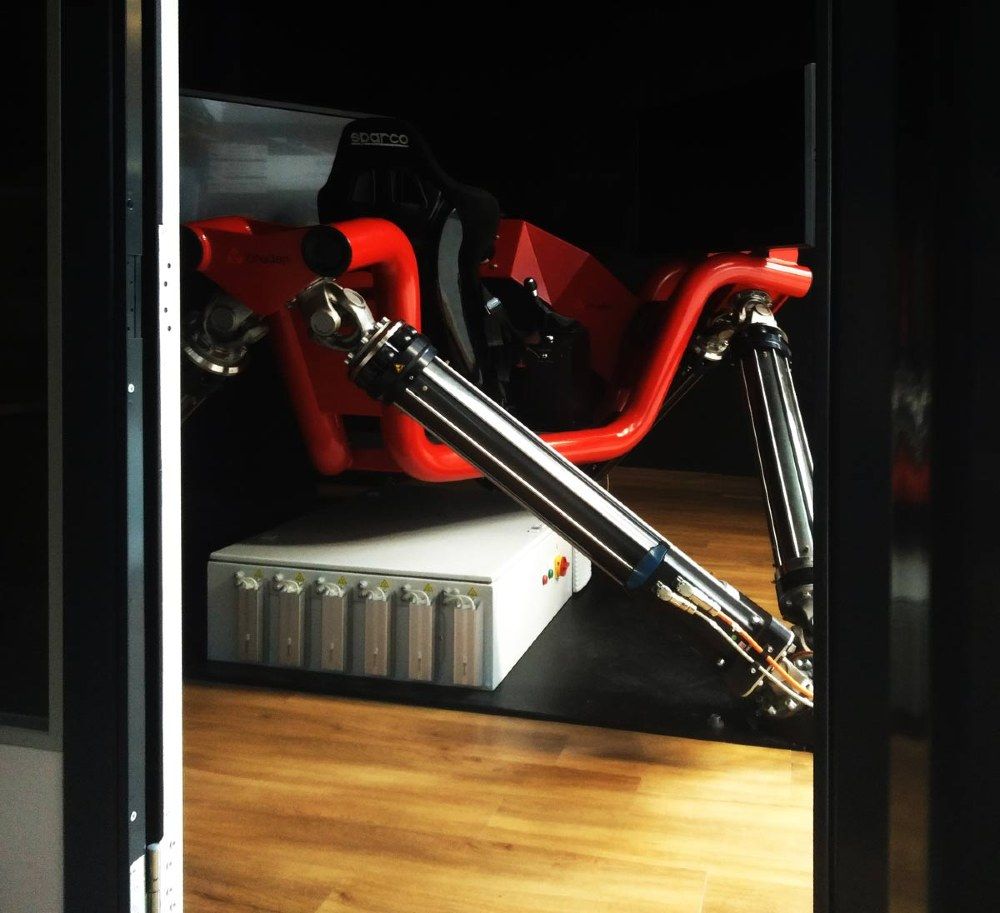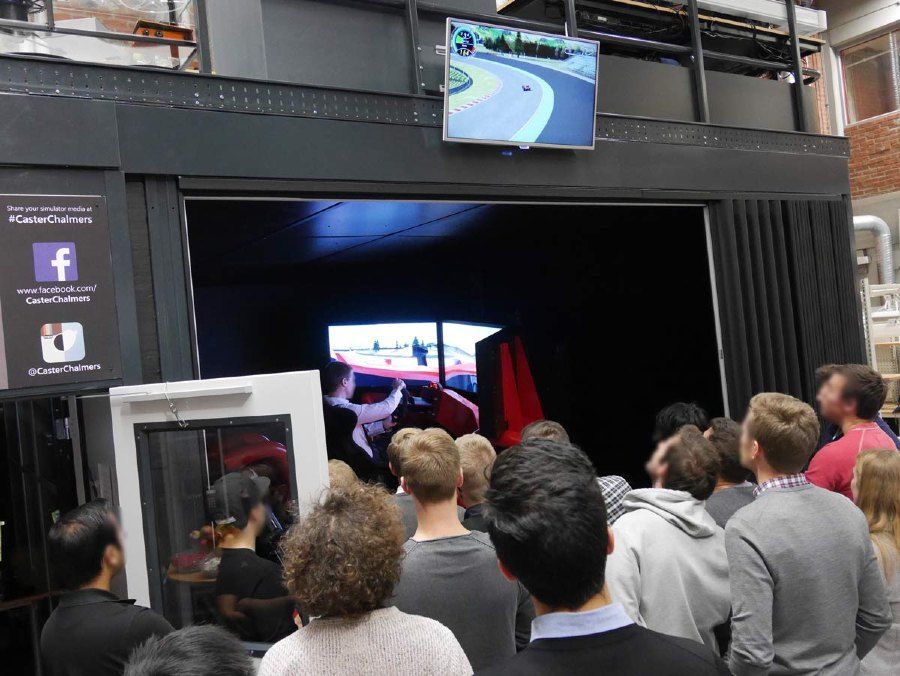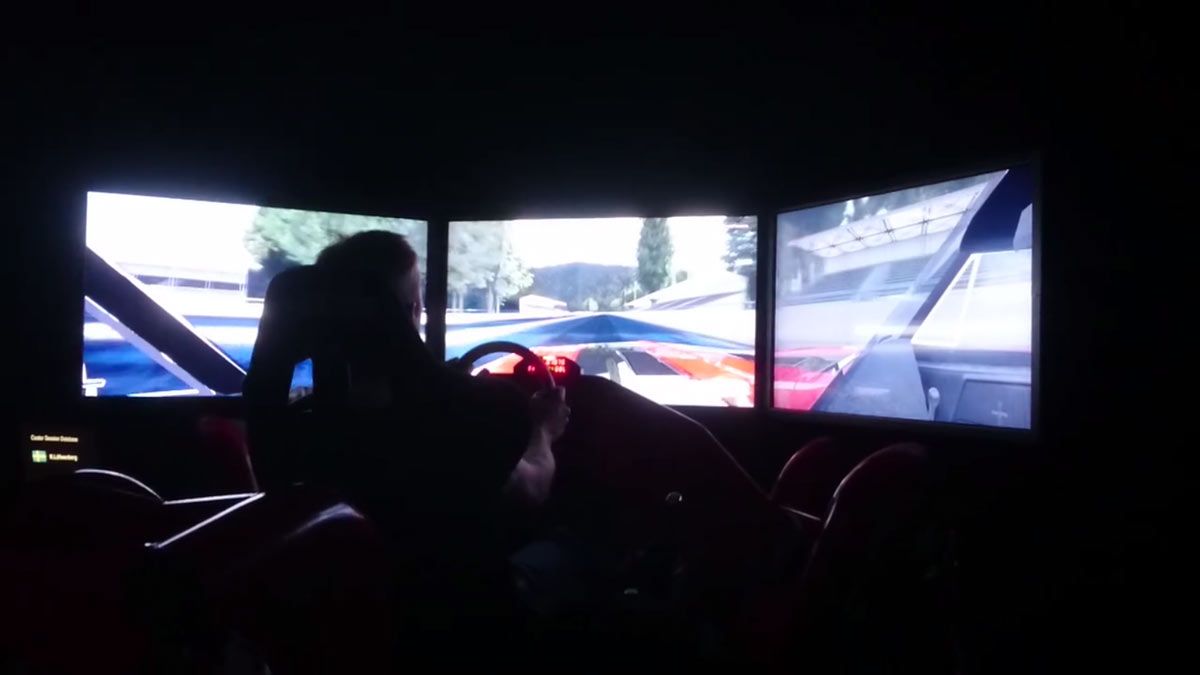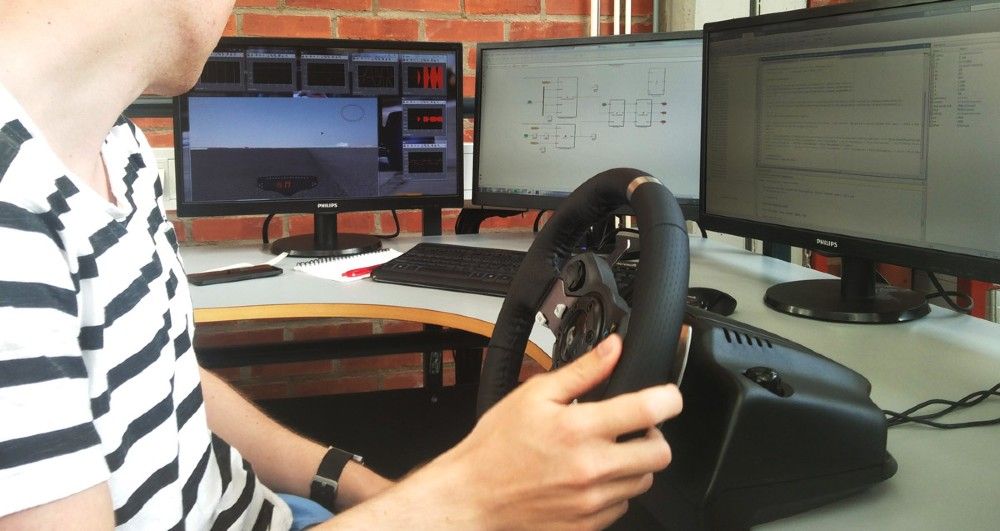Putting Student Engineers in the Front Seat with a Driver-in-the-Loop Automotive Simulator
By Håkan Richardson and Mikael Enelund, Chalmers University of Technology
The Conceive, Design, Implement, Operate (CDIO) approach to engineering education that we use at Chalmers was designed to address the industry demand for graduates who are both well-grounded in engineering principles and equipped to tackle real-world engineering problems. Hands-on projects with MATLAB® and Simulink® are fundamental to our CDIO-based curriculum because they let students see the effects of their design decisions firsthand.
Two years ago, we saw an opportunity to enable students not just to see the results of their work but to feel them, as well. We installed a driver-in-the-loop automotive simulator that moves a student through six degrees-of-freedom as they drive (Figure 1). The simulator is maintained, operated, and continuously improved by Caster, a Chalmers student organization that also helped secure the funds to purchase it. The simulator includes MATLAB and Simulink vehicle models. It has an interface that enables students to incorporate their own models and feel how their designs would perform on a real vehicle.
The mechanical engineering program has integrated the Caster simulator into a first-year undergraduate programming course and a masters-level course in vehicle dynamics. More importantly, the facility that houses the simulator has emerged as a gathering place for students interested in learning more about automotive engineering outside a specific course (Figure 2).
Teaching First-Year Programming with the Simulator
MATLAB is an essential component of the engineering curriculum at Chalmers, and we require all undergraduates to take Programming with MATLAB in their first year.
To provide students with a positive introduction to programming, we incorporated the Caster simulator into the first course assignment. The students were asked to write an algorithm in MATLAB that set the appropriate gear based on parameters such as engine speed (in rpm) and vehicle speed. During simulations, the Castor simulator’s MATLAB model transmitted these parameters in real time as a stream of telemetry data.
The students’ algorithms were tested in a drag race with a simulated Camaro SS. The students with the fastest times in an initial round of desktop simulations advanced to the finals, in which they sat in the Caster simulator as the simulated Camaro raced down the drag strip (Figure 3).
Developing a shifting algorithm from scratch is daunting for students new to programming, so we provided a rudimentary algorithm that simply shifted from first to fourth gear when the vehicle reached 20 km/h. We also gave them the vehicle’s engine torque curve, gear ratios, and tire slip ratio, and delivered a short lecture on how engineers use this data to develop optimal shifting algorithms.
We expected most students to develop a straightforward implementation that simply shifted gears progressively as the car reached certain speeds. We thought maybe a handful would use the additional torque and gear ratio information in a more sophisticated algorithm. We were astonished when dozens of students began showing up at the Caster facility after school hours to ask us how they could improve their MATLAB algorithms and develop more advanced solutions. The enthusiasm generated by this project carried through the remainder of the course.
Teaching Masters-Level Vehicle Dynamics
Use of the Caster simulator in coursework is steadily expanding. At the undergraduate level, we plan to employ the simulator in a second-year machine design course in which mechanical engineering students will design a vehicle braking system in MATLAB and then run simulations to evaluate their systems’ performance.
At the graduate level, we have already incorporated the simulator into a course on vehicle dynamics. In this course, students develop their own vehicle models. Working in Simulink with a framework model we provide, the students add the necessary equations of motion to accurately capture vehicle dynamics (Figure 4).
After running offline simulations in Simulink, the students plug their models into the Caster simulator and evaluate their performance on a test track with a skid pad and an acceleration straight. We then ask the students to model three different weight distributions between the front and rear axles. They sit in the Caster simulator so that they can feel how the car reacts to each weight distribution.
Next, they run a similar set of simulations while modifying the brake balance between the front and rear axles. In the simulator they experience the effects of front brake and rear brake locking. For an automotive engineer, experiencing the motion in the simulator firsthand—rather than just seeing data plotted in a graph—provides a vivid memory and a much deeper understanding of the effects of design parameters on steering, braking, and overall vehicle dynamics.
Like their undergraduate counterparts in the introductory programming course, the graduate students were enthusiastic about their experience with the Caster simulator. In fact, after our first use of the simulator in the vehicle dynamics course, student enrollment in the follow-on course, Advanced Vehicle Dynamics, doubled.
Putting Engineers in the Front Seat
Caster’s motto, “Engineers in the Front Seat,” in many ways reflects the culture of continuous improvement at Chalmers. We want to remain at the forefront of engineering education, and are always looking for ways to improve our programs with new courses and assignments.
Caster simulator technology has already played a significant role in enhancing our curriculum, but the Caster student organization has had an even more dramatic effect. We have hosted visitors from about 20 different universities who have expressed interest in setting up a similar program.
Caster has also helped Chalmers’ recruitment efforts. When secondary school students visit our campus, we show them the simulator. We’ve seen interest among both male and female secondary school visitors; even if they are not particularly attracted to automotive technology, they still find the coding, virtual reality, and product development aspects of the program appealing.
Lastly, we have seen a very positive response from industry, including leading automotive manufacturers in Sweden. Many company representatives have spent time in the Caster lounge area talking with students about their work with the simulator. We are seeing tremendous interest in the engineers that Chalmers is producing because our graduates have not only the skills companies are looking for but a deeper understanding of engineering principles founded in their experience with CDIO principles and hands-on technology, including the Caster simulator. Some of the students involved with Caster have already gone on to work for automotive companies, and one recently started working as a game developer for a company that produces racing video games.
MATLAB and Simulink at Chalmers
The CDIO approach to engineering education relies heavily on modeling and simulation, and at Chalmers we use MATLAB and Simulink for these activities. As a result, for our engineering students, MATLAB is as widely used as pen and paper. MATLAB and Simulink are integrated deeply into the mathematics and engineering curriculum at Chalmers. This integration has been enabled by a Total Academic Headcount license, which provides Chalmers students with campus-wide access to the tools.
Our adoption of the CDIO approach with MATLAB and Simulink has led to improved learning outcomes and contributed to a wider recognition of Chalmers as a top-ranked technical university. Our mechanical engineering program was awarded Centre of Excellence status by the National Swedish Agency for Higher Education and Best Engineering Education by the Swedish engineering employers’ organization. After a recent evaluation of higher education, the Swedish government awarded Chalmers’ Mechanical engineering program the highest distinction, an honor that came with additional financial support that helped fund the Caster program.
Published 2017 - 93160v00



